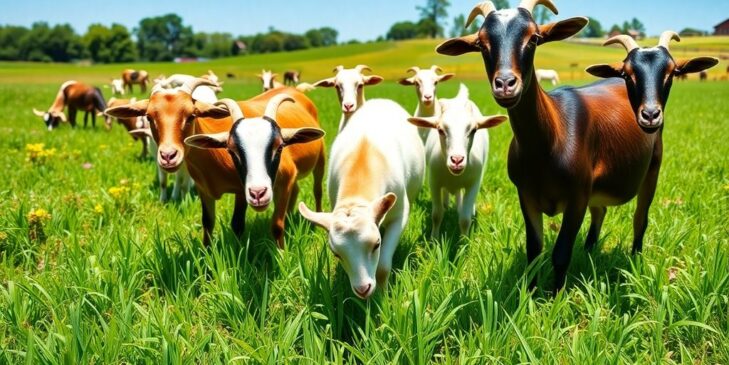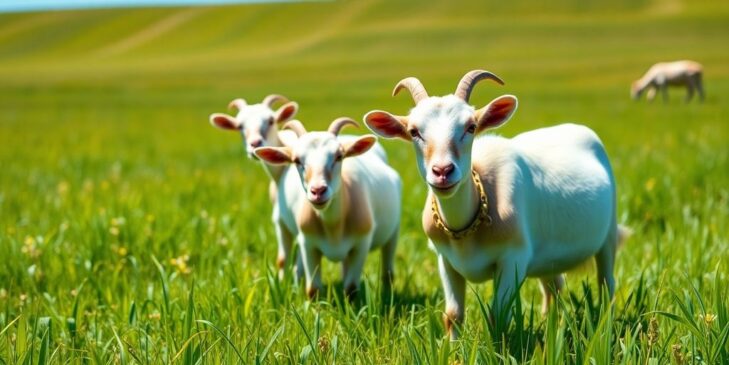Getting into goat farming in the U.S.? You might be wondering how to find the right financial support. The government offers various grants and loans to help you get started or expand your farm. From federal programs to state-specific opportunities, there’s a lot to explore. Whether you’re a new farmer or looking to grow your existing business, understanding the available options can make a big difference. Let’s break down the key takeaways to help you navigate this process.
Key Takeaways
Understanding Goat Farming Grants and Loans
Types of Grants Available for Goat Farmers
Grants for goat farming can come from various sources, including federal, state, and private organizations. Federal grants are often provided through the USDA, focusing on sustainable farming practices and rural development. State grants might target specific agricultural needs within the state, such as improving local food systems or enhancing conservation efforts. Additionally, private grants can support innovative farming methods or specific community goals.
Eligibility Criteria for Goat Farming Loans
To qualify for a loan, goat farmers need to meet specific criteria, which can vary based on the loan type and provider. Typically, applicants must demonstrate their farming experience, provide a detailed business plan, and have a good credit score. Some loans, like those from the Farm Service Agency, may offer special terms for beginning farmers or those in disadvantaged communities.
How to Apply for Goat Farming Financial Assistance
Applying for financial assistance involves several steps, starting with identifying the right type of grant or loan for your needs. Next, gather all necessary documents, such as tax returns, financial statements, and a business plan. The application process may also include interviews or site visits to assess the farm’s viability.
Securing financial assistance for goat farming can be a game-changer, allowing farmers to expand their operations and improve sustainability practices. It’s crucial to thoroughly research and prepare to increase the chances of approval.
Federal Programs Supporting Goat Farming

USDA Grants for Goat Farmers
The U.S. Department of Agriculture (USDA) offers several grant programs aimed at supporting goat farmers. These grants can be a lifeline for farmers looking to expand or innovate their operations. One of the notable programs is the Value Added Producer Grants, which helps farmers develop new products and expand their markets. This program is particularly useful for goat farmers interested in diversifying their product offerings or entering new markets.
Farm Service Agency Loan Programs
The Farm Service Agency (FSA) provides a variety of loan programs to support goat farmers. These loans can be used for purchasing livestock, equipment, and even real estate. Here are some key loan programs:
Special Initiatives for Beginning Farmers
The federal government also has initiatives specifically designed for beginning farmers. These programs aim to lower the barriers to entry for new goat farmers and include the following:
Starting a goat farming business can be daunting, but with the right financial support, new farmers can overcome initial hurdles and establish successful operations.
State-Specific Opportunities for Goat Farmers
Grants and Loans in Texas for Goat Farming
In Texas, goat farmers can tap into several specific opportunities to boost their operations. The Texas Young Farmer Grant (YFGP) is particularly aimed at young farmers looking to make their mark in agriculture. This grant supports various agricultural initiatives, providing financial assistance to youth who are keen on goat farming. Additionally, Texas offers programs like the Beginning Farmer and Rancher Development Program, which is designed to help new farmers get started with their agricultural ventures.
California’s Support Programs for Goat Farmers
California, known for its diverse agricultural landscape, also provides numerous financial aids for goat farmers. The state offers grants through initiatives like the California Department of Food and Agriculture’s Value-Added Producer Grant. This program helps farmers enhance their products and reach wider markets. Furthermore, California’s emphasis on sustainable farming practices can be seen in its support for renewable energy projects on farms, aligning with federal funding initiatives such as the SARE grants.
Regional Differences in Goat Farming Assistance
Goat farming support varies significantly across the United States. While states like Texas and California have robust programs, others may offer different types of assistance. For instance, Minnesota provides grants for livestock investment and value-added processing, catering to farmers looking to diversify their operations. Similarly, Missouri has initiatives aimed at urban agriculture, which can also benefit goat farmers in more populated areas. Understanding these regional differences is crucial for farmers to maximize their access to available resources.
“Navigating state-specific programs can be a game-changer for goat farmers. By leveraging local grants and loans, farmers can significantly enhance their operations and ensure long-term sustainability.”
Navigating the Application Process for Goat Farming Grants
Essential Documents for Grant Applications
Before diving into the grant application process, it’s crucial to gather all the necessary documents. Having everything organized can save you a lot of stress later on. Here’s a basic checklist to start with:
Tips for Writing a Successful Grant Proposal
Crafting a compelling grant proposal is an art. Here are some tips to make yours stand out:
Writing a grant proposal is like telling your farm’s story. Make it engaging and authentic, and don’t forget to show your passion for goat farming.
Common Mistakes to Avoid in Loan Applications
Applying for a loan can be tricky, and mistakes can cost you time and money. Watch out for these common pitfalls:
By paying attention to these details, you can enhance your chances of securing the financial assistance you need for your goat farming venture. Whether it’s through competitive grants for wetland mitigation banks or other sources, being prepared is key.
Maximizing Benefits from Goat Farming Financial Aid

Utilizing Loans for Farm Expansion
Expanding your goat farm can be a daunting task, but with the right financial aid, it becomes much more manageable. Loans can be a game-changer, allowing you to purchase more land, invest in new equipment, or increase your herd size. Here’s how you can make the most of these opportunities:
Investing in Sustainable Goat Farming Practices
Sustainability is key in today’s farming environment. By investing in sustainable practices, you not only help the environment but also improve your farm’s efficiency and profitability. Consider these strategies:
Making your farm sustainable is not just a trend; it’s a necessity for future-proofing your business.
Leveraging Grants for Marketing and Diversification
Grants can be a fantastic resource for enhancing your marketing efforts and diversifying your farm’s offerings. Here’s how to leverage them effectively:
By making strategic use of financial aid, you can significantly boost your farm’s growth and sustainability, ensuring long-term success in the goat farming industry.
Challenges and Solutions in Securing Goat Farming Grants
Overcoming Financial Barriers in Goat Farming
Securing financial aid for goat farming can be tough. Many farmers struggle with the initial costs of setting up their farms, which can be a major hurdle. Here are some common financial barriers:
To tackle these issues, farmers can explore the FSA’s one-time cost-share payment for organic dairy operations, including goats, to support their transition to organic practices. Additionally, forming cooperatives can help farmers pool resources and share costs.
Addressing Common Application Challenges
Applying for grants can be a daunting process, often filled with paperwork and strict criteria. Here are some common challenges farmers face:
To simplify the process, farmers should start by organizing all necessary documents in advance. Consulting with agricultural advisors or extension services can provide guidance through the application process.
Strategies for Improving Grant Approval Rates
Boosting your chances of grant approval involves a bit of strategy. Consider these tips:
“Securing grants isn’t just about filling out forms; it’s about telling your farm’s story and aligning it with the grant’s mission.”
By addressing these challenges head-on and employing strategic approaches, goat farmers can improve their chances of securing the financial support they need to thrive.
Success Stories: Goat Farmers Who Benefited from Grants and Loans
Case Study: A Successful Goat Farm in Alabama
In Alabama, a small goat farm transformed into a thriving business with the help of a USDA grant. The farmer, initially struggling with limited resources, applied for a grant aimed at supporting livestock farmers. With the funds, they were able to purchase better feed and improve their farm infrastructure. The impact was immediate, leading to healthier goats and increased milk production. This success story highlights how strategic use of grants can turn around a farm’s fortunes.
How a New York Goat Farmer Expanded with Federal Aid
A New York goat farmer took advantage of the USDA’s online tools to discover suitable loans and apply for direct financial assistance. This farmer, eager to expand, used the funds to acquire additional land and invest in new breeding stock. The federal aid not only facilitated expansion but also helped in diversifying their farm’s offerings, ensuring a stable income stream. The strategic application of federal resources demonstrates the potential for growth when opportunities are seized.
Lessons Learned from Experienced Goat Farmers
Experienced goat farmers often share key insights into successfully navigating the grant and loan application process. Here are some lessons they’ve learned:
“Persistence and preparation are key. Many farmers give up too soon, but those who stick with it often find the support they need to thrive.” This sentiment echoes through the stories of farmers who have successfully secured financial aid.
Wrapping It Up
So there you have it, folks. Getting grants and loans for goat farming in the U.S. isn’t just a dream—it’s totally doable. You’ve got a bunch of options, from government programs to local initiatives, all ready to help you get started or expand your farm. Sure, it might take some paperwork and patience, but the support is out there. Whether you’re a newbie or a seasoned farmer, these resources can make a real difference. So, roll up your sleeves, dive into the application process, and watch your goat farming dreams come to life. Happy farming!
Frequently Asked Questions
What types of grants are available for goat farmers?
Goat farmers can apply for various grants, including those for climate-smart practices, organic farming, and marketing initiatives.
How can I qualify for a goat farming loan?
To qualify for a goat farming loan, you usually need a solid business plan, proof of farming experience, and the ability to repay the loan.
What documents are needed for grant applications?
Common documents include a detailed business plan, financial statements, and proof of farming activities.
Are there special programs for new goat farmers?
Yes, there are special loan and grant programs aimed at helping beginning farmers get started with goat farming.
How do I apply for financial assistance for goat farming?
Applications can often be submitted online through government websites or local agricultural offices. Follow the specific guidelines provided.
What are common mistakes to avoid when applying for loans?
Avoid mistakes like incomplete applications, lack of a clear business plan, and failing to meet eligibility criteria.